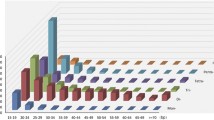Abstract
We have developed microsatellite markers (SSRs) applicable to Fagus crenata using the RAHM method and investigated their polymorphisms. We also applied the SSRs in an analysis of a closely related species, F. japonica. Here we describe the isolation and characterization of nine polymorphic microsatellite markers, of which eight are applicable to both species. Among 30 individuals of each of F. crenata and F. japonica we detected a total of 79 and 77 alleles, respectively, with an average of 9.9 and 8.6 alleles per locus. The mean expected heterozygosity (He) was 0.615 (range: 0.216–0.925) in F. crenata and 0.660 in F. japonica (range: 0.259–0.827). The He values were considerably higher than those previously found for isozymes. Paternity exclusion probabilities for multiple loci, calculated over all loci, were extremely high (0.999 and 0.998 in F. crenata and F. japonica, respectively): sufficiently high to study pollen flow in both species.
Similar content being viewed by others
Author information
Authors and Affiliations
Additional information
Received: 5 December 1998 / Accepted: 28 December 1998
Rights and permissions
About this article
Cite this article
Tanaka, K., Tsumura, Y. & Nakamura, T. Development and polymorphism of microsatellite markers for Fagus crenata and the closely related species, F. japonica. Theor Appl Genet 99, 11–15 (1999). https://doi.org/10.1007/s001220051203
Issue Date:
DOI: https://doi.org/10.1007/s001220051203




